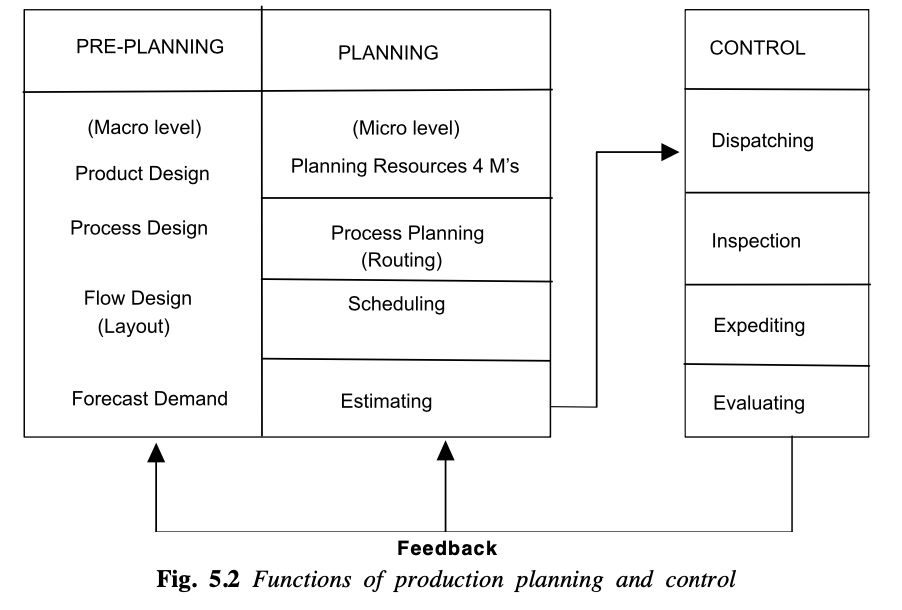Functions of Production Planning and Control
The functions of Production Planning and Control (PPC) represent the specific activities undertaken to manage the production process effectively. These functions align closely with the phases outlined previously and focus on managing the key resources and activities involved.
Production Planning and Control (PPC) is divided into three key stages:
-
Pre-planning:
- This is the initial, broad-level planning stage.
- It involves analyzing data related to forecasted demand, market trends, and product design.
- It establishes the overall planning strategy.
- Key decisions are made regarding process design, including new process development, equipment selection and replacement, and plant layout (workflow).
- Essentially, it sets the stage by determining the "how" and "with what" of production, considering available resources and capacity.
-
Planning:
- This stage begins once the specific production task is defined.
- It involves a detailed analysis of the "four Ms": Machines, Methods, Materials, and Manpower.
- Process planning (routing) is a core component.
- Both short-term and long-term planning are conducted.
- Emphasis is placed on standardizing and simplifying products and processes.
-
Control:
- This stage focuses on implementing and monitoring the production plan.
- It includes activities like dispatching orders, inspecting quality, expediting materials, and analyzing work-in-progress.
- The final step involves evaluating performance and taking corrective actions based on feedback.
- Effective communication and a robust feedback system are crucial for ensuring the success of PPC.
Functions of PPC can be explained with the following parameters:
-
Materials Planning & Control:
- Activity: Ensuring the right quality and quantity of raw materials, components, and bought-out parts are available at the right time.
- Includes: Material specification, determining requirements (linked to MRP), planning delivery dates, managing inventory levels, making procurement/make-or-buy decisions, and variety reduction (standardization).
-
Methods Planning (Process Planning):
- Activity: Determining how a product will be manufactured. Selecting the most suitable production processes and sequence of operations.
- Includes: Analyzing alternatives, developing process specifications, defining operation sequences, considering technological constraints.
-
Machines and Equipment Planning:
- Activity: Ensuring the necessary production facilities (machines, tools, equipment, jigs, fixtures) are available and capable.
- Includes: Analyzing facility capacity, planning for maintenance to minimize downtime, ensuring availability of appropriate tooling.
-
Routing:
- Activity: Defining the specific path or sequence of operations through different departments or work centers that a raw material/component will follow to become a finished product.
- Includes: Fixing the travel path (considering layout), breaking down the overall process into detailed operations, assigning operations to specific machines/departments.
-
Estimating:
- Activity: Determining the time required to perform each operation.
- Includes: Analyzing operations based on methods and routing, applying work measurement techniques (time study, predetermined motion time systems) to establish standard times for setup and processing. These times are crucial inputs for scheduling and costing.
-
Loading:
- Activity: Assigning specific jobs or work orders to specific work centers, machines, or personnel based on their capacity and capabilities.
- Includes: Balancing the workload across resources to ensure efficient utilization and avoid bottlenecks or idle capacity.
-
Scheduling:
- Activity: Preparing a timetable for production. Determining the start and completion dates/times for each operation and job.
- Includes: Sequencing jobs based on priorities (e.g., due dates, processing times), coordinating machine availability, aligning with overall delivery commitments.
-
Dispatching:
- Activity: The execution function – authorizing the start of production activities according to the schedule.
- Includes: Releasing work orders, material issue authorizations, tool requisitions, time tickets, and other necessary instructions to the shop floor.
-
Expediting (Follow-up / Progressing):
- Activity: Monitoring the progress of work against the schedule, identifying delays or potential problems, and taking necessary actions to keep production on track.
- Includes: Tracking materials, work-in-process, and assemblies; identifying bottlenecks; initiating corrective actions (e.g., chasing suppliers, reallocating resources).
-
Inspection Interface:
- Activity: Coordinating with the quality control function to ensure inspections are performed at appropriate points and receiving feedback on quality issues.
- Importance: Quality problems can significantly disrupt schedules and require replanning.
-
Evaluation:
- Activity: Analyzing overall performance data (completion times, costs, resource utilization, quality levels) against plans and standards.
- Includes: Identifying weaknesses, understanding reasons for deviations, providing feedback to improve future planning and control efforts. Requires effective communication and data analysis.
Indian Example: Tata Motors manufacturing commercial vehicles executes all these functions. Materials Planning ensures timely arrival of thousands of components. Methods Planning & Routing define the complex assembly sequence. Estimating sets time standards for each assembly task. Loading & Scheduling assign specific truck models to assembly lines and determine daily/weekly output targets. Dispatching releases orders to start assembly. Expediting tracks progress and resolves component shortages. Evaluation analyzes production efficiency and cost variances.
These functions work together in an integrated manner to manage the production system from planning through execution and control.


No Comments